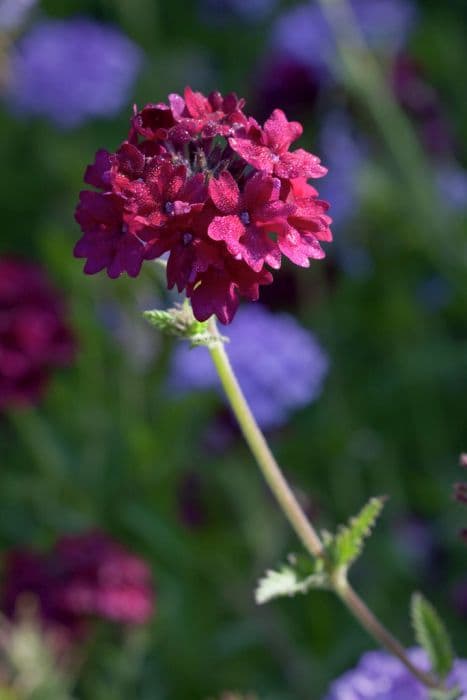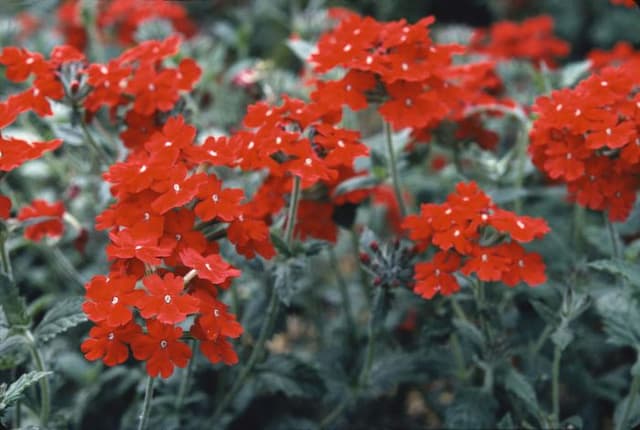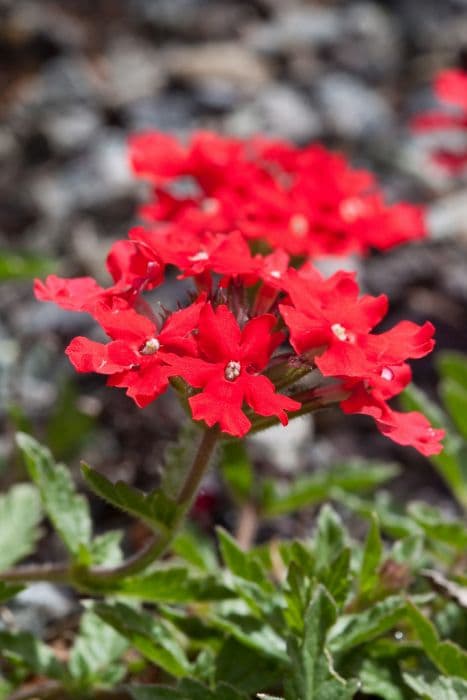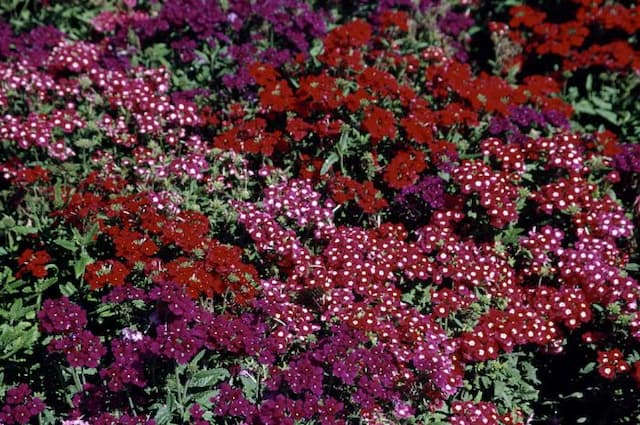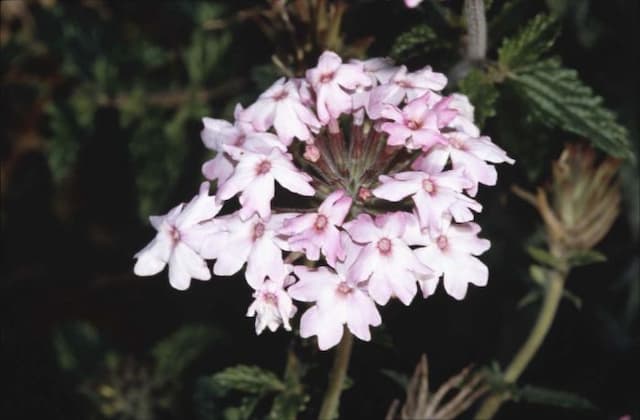Slender Vervain Verbena rigida

ABOUT
Verbena rigida, commonly known as slender vervain, is an attractive perennial plant with a bushy and sprawling habit. It is characterized by its rough, square-shaped stems and elongated leaves that have a rough texture and are deeply veined. These leaves are usually dark green in hue, providing a backdrop for the showy flowers. The slender vervain blooms profusely with small, tubular flowers that are tightly clustered along upright, terminal spikes. These vibrant flowers can range in color from purple to violet and are known to attract butterflies and other pollinators. The slender vervain typically blooms from midsummer through the fall, presenting a long season of color in the garden. Its striking flower spikes rise above the foliage, creating a textural and visual contrast. The overall appearance of slender vervain is that of a low-maintenance, sun-loving plant that brings a burst of vivid color and an airy, open structure to a planting space, perfect for borders, rock gardens, or as a part of a mixed herbaceous border.
About this plant
 Names
NamesSynonyms
Slender Vervain, Tubular Vervain, Rigid Verbena, Hardy Garden Vervain, Sandpaper Verbena.
Common names
Verbena venosa, Verbena rigida var. lilacina, Verbena rigida var. congesta, Verbena rigida var. rigida.
 Toxicity
ToxicityTo humans
The plant known as stiff verbena is not generally considered highly toxic to humans. However, as with many plants, it can cause mild irritation to some individuals when handled or ingested. It's important to note that the ingestion of any part of this plant is not advisable due to the potential for gastrointestinal upset, as it is not intended for human consumption. If large quantities were to be ingested, one might experience symptoms such as nausea, vomiting, diarrhea, or abdominal pain. In any case, if ingestion occurs and any troubling symptoms arise, medical attention should be sought.
To pets
Stiff verbena is not commonly listed as a toxic plant to pets such as dogs and cats. However, as with humans, ingestion of stiff verbena can cause mild to moderate gastrointestinal upset for some animals. If a pet ingests a significant amount of the plant, symptoms like vomiting, diarrhea, or abdominal discomfort could occur. Although serious toxicity is unlikely, it's always prudent to keep an eye on your pet and consult with a veterinarian if they consume any part of this plant and exhibit adverse reactions.
 Characteristics
CharacteristicsLife cycle
Perennials
Foliage type
Deciduous
Color of leaves
Green
Flower color
Purple
Height
1-3 feet (0.3-0.9 meters)
Spread
1-2 feet (0.3-0.6 meters)
Plant type
Herb
Hardiness zones
7
Native area
South America
Benefits
 General Benefits
General Benefits- Attracts Pollinators: Verbena rigida is a nectar-rich plant that attracts bees, butterflies, and other beneficial insects to the garden.
- Drought Tolerance: Once established, it can withstand periods of low water availability, making it suitable for xeriscaping and arid climates.
- Low Maintenance: This plant requires minimal care once established, needing only occasional watering and the removal of spent flowers to encourage more blooms.
- Erosion Control: Its root system helps stabilize the soil, which can be particularly beneficial on slopes or areas prone to erosion.
- Landscape Design: Verbena rigida adds vibrant color and texture to garden beds, borders, and containers with its vivid purple flowers and lance-shaped leaves.
- Long Blooming Period: It offers a long season of blooms, usually from early summer until the first frost, providing sustained color in the garden.
- Fragrance: The plant's flowers can add a pleasant scent to the garden, enhancing the sensory experience of the space.
- Ground Cover: Its spreading habit makes it useful as ground cover, filling in garden spaces and suppressing weeds.
- Wildlife Habitat: Beyond pollinators, it also provides habitat for other wildlife, like birds that may feed on the seeds.
- Easy to Propagate: Verbena rigida can be easily propagated from seed or cuttings, allowing gardeners to expand their plantings without significant expense.
 Medical Properties
Medical PropertiesThis plant is not used for medical purposes.
 Air-purifying Qualities
Air-purifying QualitiesThis plant is not specifically known for air purifying qualities.
 Other Uses
Other Uses- Verbena rigida, commonly known as slender vervain, is sometimes used as a natural dye, where its parts can be boiled down to produce a range of colors for fabric dyeing.
- It can serve as a ground cover plant due to its dense growing habit, which helps to suppress weeds in garden beds.
- The slender vervain's vibrant flowers are used in ornamental floral arrangements, both fresh and dried, to add a splash of color.
- It is utilized in butterfly gardens, as the flowers are known to attract various butterfly species, aiding in pollinator conservation.
- Slender vervain can be planted as part of a “living mulch” system in agriculture, improving soil quality and retaining moisture.
- The plant's nectar-rich flowers provide a food source for hummingbirds, making it ideal for creating a bird-friendly garden.
- Its hardy and resilient growth habit allows it to be used for erosion control in sloped areas and along highways.
- It's sometimes incorporated into meadow gardens or wildflower plantings to provide a natural, low-maintenance landscaping option.
- Gardeners may use the plant as an edging species in perennial borders due to its neat, compact growth pattern.
- The slender vervain may be used in companion planting to create a beneficial habitat for predatory insects that help control pests.
Interesting Facts
 Feng Shui
Feng ShuiThe plant Verbena is not used in Feng Shui practice.
 Zodiac Sign Compitability
Zodiac Sign CompitabilityThe plant Verbena is not used in astrology practice.
 Plant Symbolism
Plant Symbolism- Healing: Verbena has a longstanding association with divine and supernatural forces, and has been used in various folk traditions for its healing properties.
- Protection: The plant is believed to offer protection against harm and was often used in rites and rituals.
- Harmony: Verbena is known for fostering harmony and can be used to restore peace and balance in various aspects of life.
- Purification: It is used in cleansing rituals to purify spaces, objects, or individuals from negative energies.
- Love: In some cultures, verbena is associated with love and is used in spells or charms to attract or maintain romantic affection.
 Water
WaterThe rigid verbena, or Verbena rigida, prefers a moderate watering routine, allowing the soil to dry out slightly between waterings. In general, rigid verbena should be watered once every week with about 1-2 inches of water, adjusting for rainfall and temperatures. Overwatering can lead to root rot, so ensure good drainage in the soil. During hot, dry periods, you may need to water more frequently. For container-grown plants, check the soil moisture level more often since pots can dry out faster.
 Light
LightRigid verbena thrives in full sunlight conditions, requiring at least 6 to 8 hours of direct sunlight daily for best flowering and growth. It is an ideal plant for spots in the garden that receive long hours of unfiltered sun. However, in extremely hot climates, a bit of afternoon shade can prevent scorching.
 Temperature
TemperatureRigid Verbena fares well in a wide range of temperatures, but it grows best when the temperature stays between 65°F and 85°F. The plant can tolerate a minimum temperature down to 15°F, although it may die back to the ground with heavy frost. It can withstand high temperatures as long as it receives adequate moisture.
 Pruning
PruningPruning the rigid verbena helps to promote bushier growth and more flowers. It's best pruned in early spring or after flowering to remove dead flowers and encourage a second bloom. Typically, pruning can be done every few months during the active growing season to maintain shape and health.
 Cleaning
CleaningAs needed
 Soil
SoilVerbena bonariensis, commonly known as rigid verbena, thrives in well-draining, loamy or sandy soil with a pH of 6.0 to 7.5. For the best soil mix, combine two parts garden soil, one part compost, and one part perlite or coarse sand to ensure proper drainage.
 Repotting
RepottingRigid verbena, often known as Verbena bonariensis, generally does not require frequent repotting as it is mostly grown as an annual. If grown as a perennial, repot every 2-3 years or when it outgrows its container.
 Humidity & Misting
Humidity & MistingVerbena bonariensis, also called rigid verbena, prefers a moderate humidity level but is quite adaptable and can tolerate the typical range found in most outdoor environments.
 Suitable locations
Suitable locationsIndoor
Place rigid verbena in bright, indirect light with good air flow.
Outdoor
Plant rigid verbena in full sun with well-draining soil.
Hardiness zone
7-11 USDA
 Life cycle
Life cycleVerbena rigida, commonly known as slender vervain, begins its life as a seed, which, when conditions are right—warm temperatures and moist soil—it germinates and emerges as a seedling. The seedling grows into a vegetative state with elongated, lance-shaped leaves and a sturdy stem, through which it undergoes vegetative growth and development. During the flowering stage, typically in late spring to summer, the plant produces dense, slender spikes of small, vivid purple flowers that are attractive to pollinators like bees and butterflies. After pollination, the flowers develop into small, brownish nutlet fruits, each containing seeds for the next generation. As the growing season ends, if the conditions are not favorable for overwintering, the plant may die off, completing its annual life cycle, or it may behave as a perennial in warmer climates by entering a period of dormancy before sprouting again in the spring. Dispersal of seeds occurs through wind, water, or animals, facilitating the spread of slender vervain to new locations where the life cycle starts anew.
 Propogation
PropogationPropogation time
Spring-summer
Propogation: The most popular method of propagating Verbena rigida, commonly known as rigid verbena, is through seed. Sowing can begin in late winter to early spring, typically around February to March for many regions. You can start the seeds indoors using seed-starting trays or small pots filled with a well-draining soil mix. Place the seeds lightly on the soil surface, pressing them gently into the soil without covering, as verbena seeds need light to germinate. Keep the soil moist but not soggy, and maintain a temperature between 70 and 75 degrees Fahrenheit (21 to 24 degrees Celsius) to encourage germination, which usually occurs within 14 to 30 days. Once seedlings are large enough to handle and after the risk of frost has passed, you can transplant them outdoors, spacing them about 10 to 12 inches (25 to 30 centimeters) apart to allow for growth and air circulation.
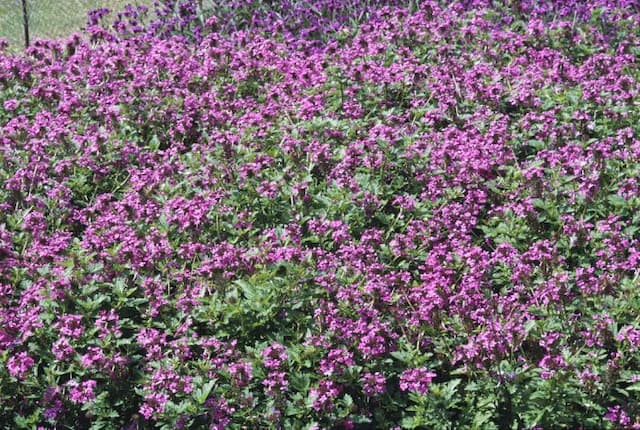
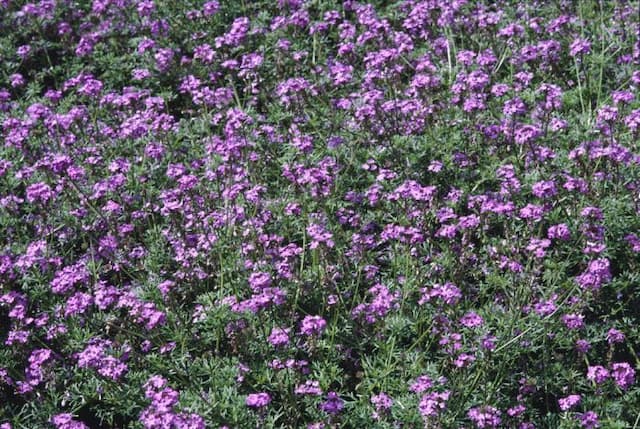
![Vervain [Endurascape Pink Bicolor]](/_next/image?url=https%3A%2F%2Fplants-admin.emdemapps.com%2Fimages%2Fplants%2F%2Fimages%2F604b594e749b0.png&w=640&q=75)
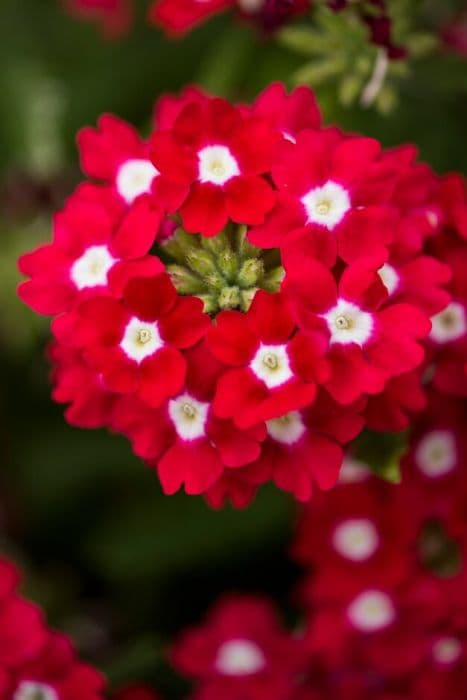
![Vervain [Seabrook's Lavender]](/_next/image?url=https%3A%2F%2Fplants-admin.emdemapps.com%2Fimages%2Fplants%2F%2Fimages%2F604b650ea9729.png&w=640&q=75)
